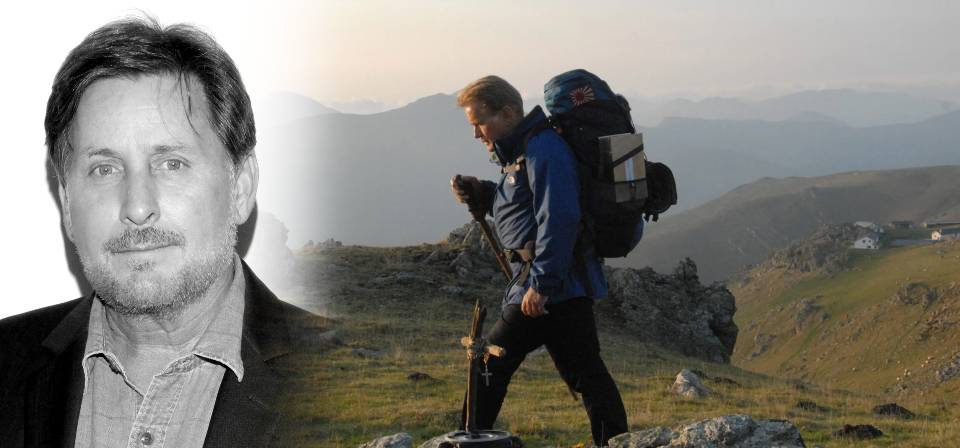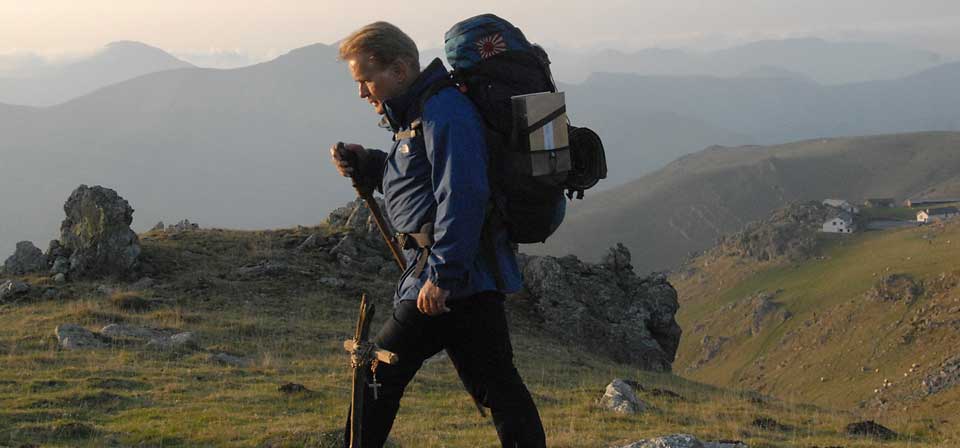Take a Lenten pilgrimage to Santiago — at the movies
Santiago: The Camino Within, a 68-minute documentary narrated by Bishop Donald Hying, is in theaters one day only — Tuesday, March 28 — courtesy of Fathom Events.
Like many people, I first learned about the Camino de Santiago, or Way of St. James, from the 2011 movie The Way. The Camino is a network of pilgrimage routes throughout Spain, Portugal, France and beyond, all converging on the Metropolitan Archcathedral Basilica of Santiago de Compostela in Galicia, Spain, the traditional resting place of the remains of St. James the Great. A father-son collaboration between Catholic actor Martin Sheen, who stars, and his agnostic son Emilio Estevez, who wrote and directed, The Way is a dialogue of sorts between the sacred and the secular; and the Camino itself, which hosts hundreds of thousands of pilgrims every year with a wide range of beliefs, is a fitting context for such a dialogue.
There are a number of documentaries about the Camino, typically following a number of pilgrims traveling together or separately on their journey to Santiago. Where documentaries like Walking the Camino: Six Ways to Santiago and Looking for Infinity are basically humanistic and individualistic in outlook, focusing on psychological and cultural reasons for walking the Camino, Santiago: The Camino Within, from the Catholic nonprofit Ahava Productions, follows a pilgrimage group led by Bishop Donald Hying of Madison, Wisconsin, who narrates the film, centering the Camino’s religious nature.
Bishop Hying’s pilgrimage group begins at Zaragoza in Aragon, following the Camino Catalán to Logroño, where it joins the popular Camino Frances or French Way. Some of the first images we see are of the Cathedral Basilica of Nuestra Señora del Pilar in Zaragoza, a blend of architectural styles — Baroque, Rococo, and Neoclassical — that will recur in other churches on the journey, often with Bishop Hying celebrating Mass for his own group and for others.
Other than a few low-key dramatized shots illustrating the Gospel account of the call of James and John, the sons of Zebedee, by Jesus, the documentary is constructed of images captured on the pilgrim route, including pilgrim interviews and images of the way and the landscape, from a closeup of lavender flowers to soaring drone shots of rolling golden fields and distant blue hills. The eclectic score includes pieces for guitar, piano and strings, and other instruments. In a brief moment of diegetic music, a pilgrim from Indiana plays “Ave Maria” for the camera on a seedpod ocarina, though unhappily the soundtrack adds a guitar on top of her playing.
It’s easy to take beautiful pictures of verdant landscapes and photogenic churches, but director Erin Berghouse finds other interesting images as well: a collection of walking sticks (or pilgrims’ staffs) leaning against the outer wall of a church where the pilgrims have gone to Mass; a detailed image of the Blessed Virgin tattooed across a pilgrim’s entire upper arm; a lone boot on a rock, a symbol of the journey’s end, near the shore near Señora de la Barca Sanctuary at Muxía, one of a number of terminal points on the Camino. Naturally, there are plenty of shots of people walking, too often in dramatic slow motion.
The pilgrims we meet include Spaniards as well as visitors from highly variable distances: France, Italy, Scotland, the Czech Republic, the US, South Korea, Australia. Their reasons for walking the Camino are likewise varied, though faith seems to be a significant element for many of them. Several cite the draining routine of their day-to-day lives and the need to get away. At times I was reminded of the quip of a priest in another documentary (Walking the Camino: Six Ways to Santiago) that some people start the Camino as tourists but end as pilgrims. Some interviewees seem almost to make that transition in the course of a single exchange, like the Indiana woman (the one with the ocarina) who says at first that she wasn’t sure why she wanted to walk the Camino. Only the night before, she says, she concluded that it was for the joy of interacting with people — but then she goes on to say that she evangelizes everywhere and wants to share the joy of Christ with everybody.
Perhaps the most extensive interview, and certainly the most moving, involves a couple from South Korea whose Catholic names are Stephano and Katerina. Walking as he talks, Stephano explains that they are walking the Camino ten years ahead of schedule because of the burnout he was feeling after 20 years in a demanding job. Unexpectedly, he found that a month of not checking his emails or contacting anyone in Korea led to an epiphany of gratitude for everything he wanted to escape from, including the job that allows him to support his family. Katerina says very little throughout his extraordinary monologue, but she gets choked up at the end — and when the film cuts to a wordless shot of Stephano and Katerina kneeling with Bishop Hying’s hands on their heads, you might get choked up too.
Drone videography adds a lot, though some very similar shots crop up from time to time, undercutting the sense of forward movement along the Camino path. Lack of geographical context doesn’t help. There’s an early shot of a map with the first part of the path highlighted; I would have liked to return to the map from time to time — and it would have been nice to have, along with the title cards defining “Santiago,” “pilgrimage,” and “pilgrim,” subtitles identifying cities and churches on the way. Some of this absent context could reflect creative preferences (the journey is more spiritual than geographical), but some editing choices seem a bit sloppy. About 10 minutes in we briefly meet a white-haired Scottish pilgrim on his fourth Camino; then half an hour later he reappears, introducing himself as if we hadn’t already met him.
More cultural context also would be a plus. Scallop shells are ubiquitous, and we see pilgrim passports being stamped, but neither of these conventions are explained. Toward the end, when Bishop Hying descends into the crypt of the Santiago Basilica to kneel before the reliquary containing the reputed relics of St. James, anyone familiar with church architecture and the veneration of relics will understand what’s happening, but it could have been spelled out for other viewers.
Bishop Hying has good things to say throughout. “God has placed a homing device in our hearts,” he says in a technological gloss on St. Augustine, “so that we are born restless, never setting for less than God himself.” His voice is in a similar register to another bishop more familiar in media productions, Bishop Robert Barron, perhaps giving his narration an oddly familiar feel even for viewers who may not know him. If I have a material reservation regarding Bishop Hying’s comments, it would be over his unqualified account, early in the film, of St. James evangelizing Spain and his remains being discovered in Santiago as a result of a vision given to a monk. Unlike, say, Pope Benedict XVI, who described these accounts as “later traditions” in a series of 2006 addresses on the Apostles, Bishop Hying presents them as factually as the call of James and John by Jesus.
That reservation aside, Santiago: The Camino Within is more than a worthy addition to existing films about the Camino. It’s the first Camino film I’ve seen that is fundamentally concerned with why the Camino exists in the first place, with what it is for. Watching The Way makes me want to walk the Camino. Watching Santiago: The Camino Within kind of makes me feel as if I had.
Related

The Way: Emilio Estevez on the Camino drama—in theaters one day only—and the planned sequel
Martin Sheen is back on the Camino de Santiago pilgrimage route Tuesday, May 16. His son Estevez, who wrote and directed The Way, talks about the film’s legacy and his ideas for The Way: Chapter 2.

The Way (2011)
Is there grace for such pilgrims as these? Perhaps, but it may not take the form they seem to be seeking. At the end of the road, some viewers might feel let down at what has not changed for the main characters, but perhaps this is to miss the change that matters most. Emilio has said that the film is “pro-people, pro-life.” So it is, in more ways than one.
Recent
- Benoit Blanc goes to church: Mysteries and faith in Wake Up Dead Man
- Are there too many Jesus movies?
- Antidote to the digital revolution: Carlo Acutis: Roadmap to Reality
- “Not I, But God”: Interview with Carlo Acutis: Roadmap to Reality director Tim Moriarty
- Gunn’s Superman is silly and sincere, and that’s good. It could be smarter.
Home Video
Copyright © 2000– Steven D. Greydanus. All rights reserved.